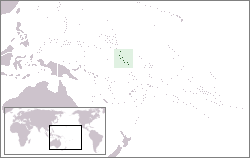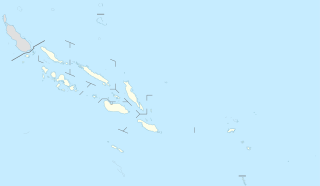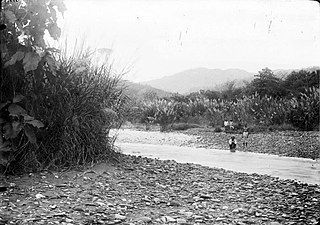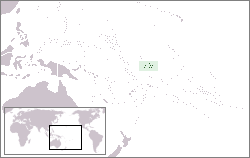
Kiribati, officially the Republic of Kiribati, is a sovereign state in Micronesia in the central Pacific Ocean. The permanent population is just over 110,000 (2015), more than half of whom live on Tarawa Atoll. The state comprises 32 atolls and reef islands and one raised coral island, Banaba. They have a total land area of 800 square kilometres (310 sq mi) and are dispersed over 3.5 million square kilometres. Their spread straddles both the equator and the 180th meridian, although the International Date Line goes round Kiribati and swings far to the east, almost reaching the 150°W meridian. This brings the Line Islands into the same day as the Kiribati Islands. Kiribati's easternmost islands, the southern Line Islands, south of Hawaii, have the most advanced time on Earth: UTC+14 hours.

The Gilbert Islands are a chain of sixteen atolls and coral islands in the Pacific Ocean about halfway between Papua New Guinea and Hawaii. They form the main part of Kiribati.

The Gilbert and Ellice Islands were a British protectorate from 1892 and colony from 1916 until 1 January 1976, when the islands were divided into two colonies which became independent nations shortly after. A referendum was held in December 1974 to determine whether the Gilbert Islands and Ellice Islands should each have their own administration. As a consequence of the referendum, the Gilbert and Ellice Islands colony ceased to exist on 1 January 1976 and the separate countries of Kiribati and Tuvalu came into existence.

The South Pacific Mandate was a League of Nations mandate given to the Empire of Japan by the League of Nations following World War I. The South Pacific Mandate consisted of islands in the north Pacific Ocean that had been part of German New Guinea within the German colonial empire until they were occupied by Japan during World War I. Japan governed the islands under the mandate as part of the Japanese colonial empire until World War II, when the United States captured the islands. The islands then became the United Nations-established Trust Territory of the Pacific Islands governed by the United States. The islands are now part of Palau, Northern Mariana Islands, Federated States of Micronesia, and Marshall Islands.

The Phoenix Islands Settlement Scheme was begun in 1938 in the western Pacific ocean and was the last attempt at human colonisation within the British Empire.
Gerald Bernard Gallagher is noted as the first officer-in-charge of the Phoenix Islands Settlement Scheme, the last colonial expansion of the British Empire.

Brief Information on First settlers:

The British Western Pacific Territories was the name of a colonial entity, created in 1877, for the administration, under a single representative of the British Crown, styled High Commissioner for the Western Pacific, of a series of Pacific islands in and around Oceania. Except for Fiji and the Solomon Islands, most of these colonial possessions were relatively minor.

British Solomon Islands Protectorate was first declared over the southern Solomons in 1893, when Captain Gibson R.N., of HMS Curacoa, declared the southern islands a British Protectorate. Other islands were subsequently declared to form part of the Protectorate over a period ending in 1900.

Nikunau is a low coral atoll in the Gilbert Islands and forms a council district of the Republic of Kiribati. It consists of two parts,, joined by an isthmus about 150 metres (490 ft) wide.

Taro Island is a small island in Solomon Islands with 507 inhabitants, capital of Choiseul Province and is located in Choiseul Bay off the northwest coast.

Nukumanu, formerly Tasman Islands, is a medium-sized atoll of Papua New Guinea, located in the Southwestern Pacific Ocean, 4 degrees south of the equator.

The British Solomon Islands Protectorate Defence Force (BSIPDF) was the British colonial military force of the British Solomon Islands Protectorate (1889–1978). The Solomon Islands has not had military forces since it achieved independence from Britain in 1976. Although the BSIPDF was very small, it played a significant role in the Solomon Islands campaign of World War II.

Ghizo Island, home to Gizo, the capital of the Western Province, Solomon Islands. The island is named after an infamous local head-hunter. It is located west of New Georgia and Kolombangara. Ghizo is home to a substantial number of people of I-Kiribati descent. These people were relocated there by the British administration of the British Solomon Islands Protectorate in the 1950s. They had previously spent 20 years on the islands of Orona and Nikumaroro, having been resettled on these previously uninhabited islands in the Phoenix Group from various islands in the Gilberts archipelago in the 1930s. The original resettlement in the 1930s was on alleged grounds of overcrowding, particularly on drought prone islands in the southern Gilberts. The second resettlement was on alleged grounds of the islands in the Phoenix group having harsh living conditions and also prone to drought, although remoteness and costs falling on the colonial administration also played parts. See also Wagina Island.
Arnarvon Islands are a group of islands in Solomon Islands; they are located in Isabel Province and nearby to Wagina Island in Choiseul Province.

Kayeli people is an ethnic group mainly living on the southern coast of the Kayeli Gulf of Indonesian island Buru, mainly from the Kaiely Gulf. From an ethnographic point of view, Kayeli are close to other indigenous people of Buru, such as Lisela and Buru.
British protectorates were territories over which the British government exercised only limited jurisdiction. Many territories which became British protectorates already had local rulers whom the Crown negotiated with through treaty, acknowledging their status whilst simultaneously offering protection. British protectorates were therefore governed by indirect rule. In most cases, the local ruler, as well as the subjects of the ruler, were not British subjects.




















